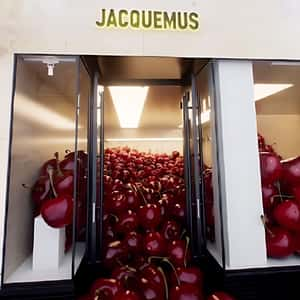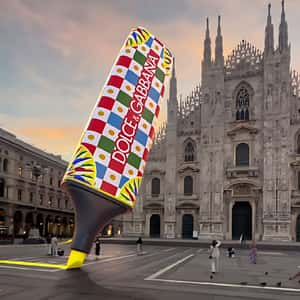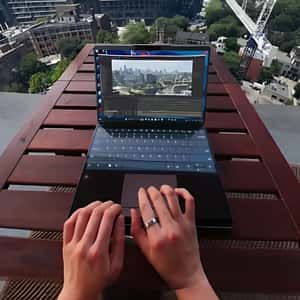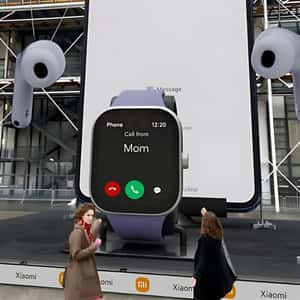FOOH: The Beginner’s Guide for Agencies
Want to explore FOOH advertising? This guide walks agencies through brainstorming ideas, finding partners, and crafting seamless campaigns.

Your average online consumer is bombarded with hundreds of ads every day. With the advertising landscape so heavily saturated, the need for innovative ads that stand out and take up real estate in an audience’s head has never been greater.
This is where Fake Out of Home (FOOH) advertising is breaking new ground.
How does FOOH Advertising work?
Fake Out of Home, also called faux OOH or faux out-of-home advertising, elevates traditional advertising to the next level by combining footage of real-life environments with hyperrealistic CGI elements.
These 10 to 15 second videos look absurd yet hyperrealistic, and this combination is exactly what grabs the attention of your audience online, making them wonder whether what they’re seeing is real or not.
Why does it work so well? Because it delivers those “wow” moments that get people talking — and sharing. Plus, it gives brands a ton of creative freedom to make visuals that would be impossible to pull off in real life or through traditional digital OOH.
Want a deeper look at how FOOH works? Check out our full guide on What Fake Out of Home is.
Advantages of FOOH Advertising for Agencies
In a crowded digital world, FOOH stands out — and gives agencies a real edge.
With it, you can:
- Craft surreal, high-impact visuals without needing expensive physical builds.
- Tell stronger stories by blending real-life settings with unexpected CGI twists.
- Save on costs while still delivering impressive, premium-looking campaigns.
Smaller agencies in particular can punch above their weight, producing work that looks just as slick as the big players — without spending a fortune.
But: great FOOH needs expertise. From precise motion tracking to seamless VFX, this format requires working with skilled CGI artists and digital production studios who know the ins and outs.
The takeaway? With the right creative partners, FOOH becomes a powerful storytelling tool that grabs attention and delivers results.
For more inspiration, check out our FOOH library!
A Simple 4-Step Guide To FOOH Ads
Fake Out of Home advertising, sometimes referred to as CGI ads, is transforming how brands draw attention in online spaces. In today’s crowded digital landscape, this unique approach of blending real-world scenes with CGI animation creates a fusion that stops audiences in their tracks.
But producing a FOOH ad takes more than beautiful visuals, it’s about combining strategy, creativity, and execution. Here’s a simple breakdown of the steps involved to bring your FOOH ad to life:
1. Creating a compelling concept
Think about where and when your ad will happen — the setting and timing matter. A strong hook in the first few seconds is key.
With FOOH, there are no limits. Go big. Flying lipstick in Times Square? Sure. Giant handbag on a Paris street? Why not. The whole point is making something so unexpected, it feels real and surreal at the same time.
But don’t just chase shock value — make sure your concept connects with your audience and fits your brand’s tone.
2. Validating your idea and creating a timeline
Not every wild idea will work, so it’s crucial to validate your concept with a team of experts who can assess its feasibility.
Our library offers a valuable resource for this process, showcasing successful FOOH ads and their creators.
This involves checking if the idea fits within your budget, timeline, and resources, as well as selecting the right production studio to handle the job.
Look for studios with proven experience in FOOH projects, they’ll not only understand the technical challenges but also take care of legal work, like getting the necessary permissions and adhering to guidelines when filming landmarks or iconic attractions.
Studios > freelancers when you want a smoother, more reliable process. They’ll manage permits, high-quality shoots, and post-production under one roof.
Budget tip: You can cut costs by considering a hybrid approach. Some agencies work with in-house videographers for the live-action footage and then collaborate with specialized CGI studios for post-production. This can help cut costs while still delivering polished results.
And don’t forget: a good studio will help build a solid timeline so everything runs smoothly from start to finish.
3. Planning and shooting the video
With your concept ready, it’s time to lock down the logistics.
Make a storyboard or previs doc to get everyone aligned visually. Choose your location wisely — lighting and atmosphere matter more than you think.
When filming:
- Avoid quick pans – they make CGI tracking harder.
- Stick to smooth shots with stable lighting.
- Be aware of social media overlays like buttons that might block parts of your ad.
If you don’t have your own video team, find a 3D studio that can shoot the footage too. It’ll make everything more cohesive and way less stressful.
4. Fine-tuning your FOOH ad
Once your video is shot, the real magic happens in post-production. Your 3D partner will use software tools like Blender, Houdini, Cinema 4D or others to enhance visuals and add realistic 3D objects like smoke, fire, or water.
No matter if you have your own VFX department or if you work with an animation or VFX studio, make sure to provide concise and detailed feedback. Vague comments like “make it pop” won’t cut it. Changes in fake out of home work are very often not a quick change and can take up to 2-4 days of effective working time.
Once your FOOH ad is live, don’t skip giving credit to everyone who helped bring it to life. Acknowledge your partners – digital marketing agencies or production studios – after all, they played a huge role in transforming your idea into reality.
Why should you consider Fake Out of Home advertising in your marketing strategy? Head over to our blog to learn Why FOOH Advertising is Important for your Success in 2025.
3 Best Practices for Running Successful FOOH Campaigns
Planning a FOOH campaign is all about combining creativity with strategy. Whether your goal is to go viral or just make an impactful statement for your brand, following a few tried-and-true methods can help you stand out. Here are three best practices to keep in mind:
1. Tap into the increasing demand
As more brands turn to FOOH to stand out and grab attention, the demand for experts in this space is skyrocketing. For brand agencies and marketing agencies, this is a huge opportunity to stand out and become leaders in a field that’s still gaining momentum.
To stay ahead, don’t hesitate to try out new, bold ideas.
This is an industry that thrives on creativity and fresh concepts. The more you explore and push boundaries, the better positioned you’ll be to lead the charge in the future of advertising.
Nevertheless make sure to always get some insights how complex your idea is. Workload can vary crazy in FOOH advertising.
Some effects and objects are rather easy to create, some others are loads of work. Working with experts will help you navigate projects successfully.
2. Use the right KPIs to measure success
When it comes to FOOH campaigns, tracking your performance is crucial. Thankfully, many digital ads examples – such as display advertising, video ads, or social media campaigns – are already on platforms with existing metrics, so you don’t have to start from scratch.
Key performance indicators (KPIs) like engagement rates, impressions, and social media shares are the best way to measure if your campaign is connecting with the audience.
Of course, setting clear goals from the beginning helps you understand which metrics matter most for your brand. With these KPIs you’ll get an accurate picture of how well your FOOH ad is performing, and it’ll give you the insights you need to tweak your strategy and refine your approach to make each campaign more effective than the last.
Set clear goals from the start to understand which metrics matter most for your brand. These KPIs will give you an accurate picture of your ad’s performance and offer insights to refine your approach, making each campaign better than the last.
Sharing performance insights with clients is also a great way to showcase success. For example, reporting on the performance of your FOOH ad compared to other campaigns helps reinforce your commitment to delivering results.
3. Learn from Great Examples
If you’re looking for inspiration, there are tons of excellent FOOH campaigns to learn from in our FOOH library.
Take Adidas’ campaign in India, for example. Set in the Himachal Pradesh Cricket Association Stadium, the ad featured a helicopter carrying a gigantic Team India jersey. The players’ awe as they watched it soar through the sky perfectly captured the essence of unity and national pride.
This campaign achieved massive success: over 47 million views, 1.3 million likes, and 7.7 million comments on Instagram.
Adidas didn’t just advertise—they made a statement. This shows how bold and creative FOOH ads can capture attention and spark conversation, both online and offline.
Why You Should Embrace FOOH Advertising
Jumping into FOOH advertising might seem daunting, but it’s easier than you think when you break it down. Focus on developing fresh ideas, partnering with experienced teams, and tracking the right KPIs to measure success. These steps will set you up for success.
Agencies and brands that embrace FOOH enjoy many benefits, like enhanced creative freedom to craft visually stunning content, cost-effective campaigns that maximize budgets, and the potential for their ads to go viral.
FOOH positions agencies as industry leaders, showing their commitment to exploring new ways to help brands stand out. The future of advertising is here, and it’s waiting for your ideas to take center stage.
For inspiration, check out our library of successful FOOH ads, which provides valuable insights into what works in fake out-of-home advertising.
And if you’re a creator of CGI ads, don’t forget to submit your work to our library—your example could inspire others in the FOOH community!
FAQs about FOOH
1. How does FOOH differ from traditional OOH and DOOH advertising?
FOOH goes above and beyond traditional Out-of-Home (OOH) and Digital Out-of-Home (DOOH) advertising by allowing brands to create extraordinary scenarios that blend reality with imaginative digital elements. While OOH relies on physical installations and DOOH utilizes digital screens in public spaces, FOOH leverages CGI to create experiences that would be impossible to achieve in the physical world.
2. What types of businesses can benefit from fake out of home advertising?
FOOH advertising is versatile and can benefit a wide range of businesses, including product-based companies, service providers, educational institutions, and non-profits. Any organization looking to create engaging and visually striking content can leverage FOOH to enhance their marketing efforts.
3. Do agencies need specialized skills to create FOOH campaigns?
Yes, creating effective FOOH campaigns often requires specialized skills in CGI and AR technology. Agencies should partner with experienced digital production studios or CGI experts who can navigate the technical complexities involved in producing high-quality FOOH content.
4. How do marketing agencies validate FOOH concepts before production?
Validating concepts involves brainstorming with a team of experts to assess feasibility in terms of budget, resources, and timeline. Collaborating with experienced animation and VFX studios can provide insights into what is achievable within your constraints.



